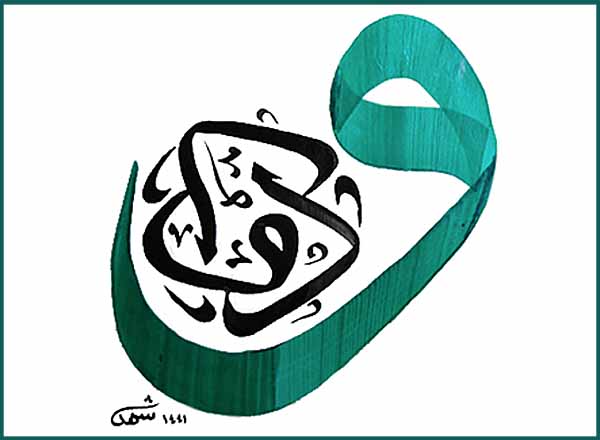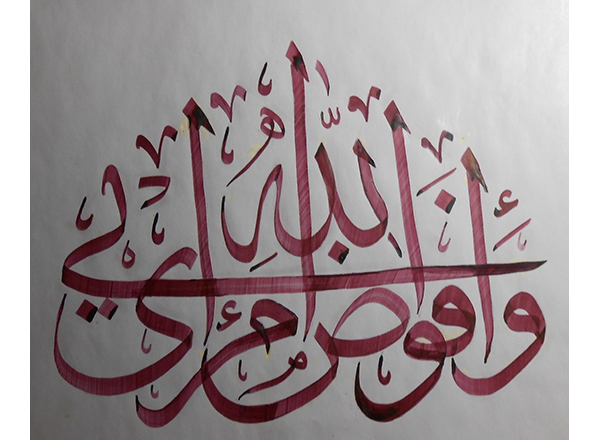HawkPride: An exercise of the pen and the soul

In the Winter 2020 Semester, Henry Ford Early College (HFEC) student Shahad Hilal completed an honors-directed research project about Islamic calligraphy. HFC art history professor Dr. Hashim Al-Tawil served as her advisor.
“She put forth an outstanding effort in her work on this project. It was very meticulous, thorough, and detailed,” said Al-Tawil, who serves as chair of HFC’s Art History Department.
Hilal's term paper was titled, “Elements of Spirituality in Traditional and Contemporary Islamic Calligraphy,” which explores humans’ intrinsic desire to venerate and beautify elements that give them a sense of spirituality and turn them into art – a trait that goes back centuries.
“I always loved and enjoyed creating various forms of art,” said Hilal. “I was drawn to Islamic calligraphy because I found a sophisticated element in the way it required specific materials and the artisanship required every step of the way, such as the preparation of the ink, the carving of the bamboo pen, and the burnishing of the paper. But mostly, I was drawn to the art’s deep connection to my faith. Islamic calligraphy surrounds a Muslim’s life wherever they turn, and it serves to create an ambiance that supports the remembrance of God, whether at the mosque, at home, or in everyday objects. I was interested in grasping the relationship between this art and its importance to the Islamic faith. All these factors sparked my interest in Islamic calligraphy.”
“Elements of Spirituality in Traditional and Contemporary Islamic Calligraphy”
Fluent in English and Arabic, Hilal, a lifelong Dearborn resident, graduated from HFEC and HFC this past spring with an associate degree in biology. She was a member of the Henry Ford II Honors Program.
When Hilal joined the honors program, she was unsure about her directed study course. She then learned Al-Tawil taught an Arabic calligraphy course. At that point, she was just getting started in calligraphy and looking for an instructor to guide her with the hope that she would one day take this course. She could not fit the course into her class schedule, so she contacted Al-Tawil to see if he would be her mentor for a directed study project on calligraphy.
“I had the honor of benefitting from his knowledge and experience in the field of Islamic art and calligraphy,” she recalled. “Before I chose a topic, Dr. Al-Tawil and I discussed my possible interests and questions in the field of calligraphy to find a topic to focus on. I was immediately intrigued. This connection between calligraphy and spirituality drew me to this art, so I decided to explore the history and development of this connection.”
Connection between art and spirituality
The purpose of Hilal’s honors project was understanding the role Islamic calligraphy plays in creating an environment that supports contemplation on the inner meaning of things rather than the external. She began this endeavor by exploring the history of this art form from its beginnings.
“None of the pre-Islamic societies considered writing a form of art, nor did they have calligraphic scripts. Arabs did not have a developed system of writing, and although Persians did have system of writing, there is no evidence of them having turned it into art or beautified it in calligraphy. It was not until after the revelation of the Islamic religion that Muslims, as a whole, beautified the words/verses that contained the spiritual teachings of Islam. Arabs, Persians, and Turks alike invested time to develop, codify, and master the different styles, scripts, measurements, and proportions of this art,” explained Hilal.
From a Western, modernist perspective, the development of calligraphy and other forms of Islamic art are mere results of social and historical development, according to Hilal. However, this opinion serves to de-Islamicize an art that was born to provide a visual way to instill the spiritual message and essence of Islam.
“Because Islamic calligraphy only emerged and developed after the revelation of Islam, and it only flourished where there was a robust, spiritual connection to Islam, it is clear that Islamic calligraphy emerged as a reaction of the hearts and souls of Muslims to the revelation,” said Hilal. “As evidence, even if one does not understand the meaning of the words, upon entering a space that is inscribed with Islamic calligraphy, one finds themselves in an environment that exudes spirituality. This demonstrates a connection between this art and spirituality. That is the topic my research sought to explore.”
Self-taught calligrapher
For Hilal, the best part of her project was the amount of research and reading that went into it. She thoroughly enjoyed exploring the topic from a variety of different sources – articles and books about masters of Ottoman calligraphy.
“Because this is a topic I really love, I enjoyed dedicating time to read and contemplate it while I was practicing and trying to improve my own art,” said Hilal. “My research served to strengthen my connection with this art, as I’m now more aware of the symbolic and spiritual importance of it.”
“Shahad is self-taught and did not have any formal training in the art of calligraphy. She has sincere fascination and spiritual engagement instead, which inspires her to produce mature works in Arabic calligraphy. With future formal study, training and continued practice, she will be a remarkable calligrapher,” said Al-Tawil.
Added Hilal: “It is worth noting I chose to refer to this art as Islamic calligraphy, rather than Arabic calligraphy, because referring to this art as exclusively Arabic does not acknowledge its history and connection to the faith that my project sought to explore. It also excludes the important role non-Arabs played in the development of this art.”
Advice to students interested in calligraphy
Hilal has some advice for students wishing to learn Islamic calligraphy. They must train in the traditional Ottoman system and learn under a master calligrapher for many years. Students are given weekly exercises and are advised to bring them to their master, who points out errors in measurement and proportion. They do not pass on to the next exercise until they are able to write the current exercise without error.
“The beauty of Islamic calligraphy lies in its harmonious system of measurement, where the height and length of each letter must complement the next,” she said. “To the master’s trained eye, a mistake 'as tiny as a flea’s wing,’ as the traditional Ottoman saying goes, disturbs the harmony of the final piece. As a result, students can train under their masters for 5-10 years before they are ready to earn their certification.”
Hilal continued: “My journey to master Islamic calligraphy has just begun. I am far from attaining perfection, but I’m enjoying the journey. This art is more than just creating beautiful pieces for your wall. It's about having the discipline to practice every day, dedication to improve, and reflection to embody the spiritual messages one is writing. It is an exercise of the pen and soul, and that is one of the reasons why I love it so much.”
First-generation college student
The eldest daughter of four, Hilal is a first-generation college student.
“As a first-generation college student, it was important for me to start off at a small, interactive environment to gain an understanding of the way college works before I went ] to a four-year university. I chose to attend HFEC for the opportunity to take college classes at HFC in an environment that allowed ample mentorship from my professors. My experience at HFC has equipped me with the tools necessary to succeed at a larger university,” she explained.
Hilal has fond memories of being in the honors program.
“The semesters I spent in the program were enlightening and intellectually challenging semesters for me,” she said. “I was exposed to topics I previously had no knowledge of, and I explored topics I thought I knew in deeper ways. I am grateful for that, for to admit that one does not know is far better than the illusion of knowledge.”
Calculus, biology, and preparation for medical school
Besides Al-Tawil, Hilal counts Dr. Rama Chidambaram, Dr. Jolie Stepaniak, Dr. Roberta Traini, Kevin Trovini, and Angela Hathikhanavala among her favorite professors at HFC.
“Many of my professors were great and accomplished individuals, and I am extremely happy to have been their student,” said Hilal. “I would list them all, but I extend my immense gratitude to Dr. Chidambaram whose efforts, kindness, and superb teaching enabled me to succeed in calculus; Dr. Stepaniak and Dr. Traini for their knowledge and passion in biology that made me look forward to every lecture and lab. I would also like to extend my gratitude to Mr. Trovini, Dr. Al-Tawil, and Ms. Hathikhanavala, my honors professors, for being key figures in my experience and enriching my education.”
This fall, Hilal will attend the University of Michigan in Ann Arbor, where she will major in neuroscience and minor in Middle Eastern Studies. She aspires to go to medical school.
“I made many great memories at HFC. I will cherish the times I spent with my friends, the times we panicked and studied together in the library (often staying late), the relief and sense of accomplishment that came after a stressful exam week. I also made great memories with many of my professors, including those who strived to ensure my success by being patient with me as my feet carried me to their office hours for the third time in one day. I am grateful for the friendships I formed and the opportunity to grow and thrive in an environment that catered to my academic success.”
